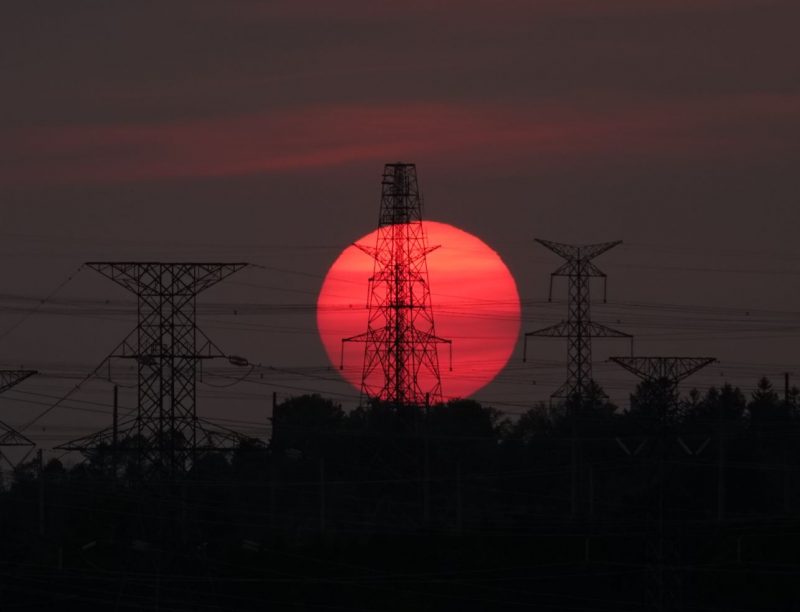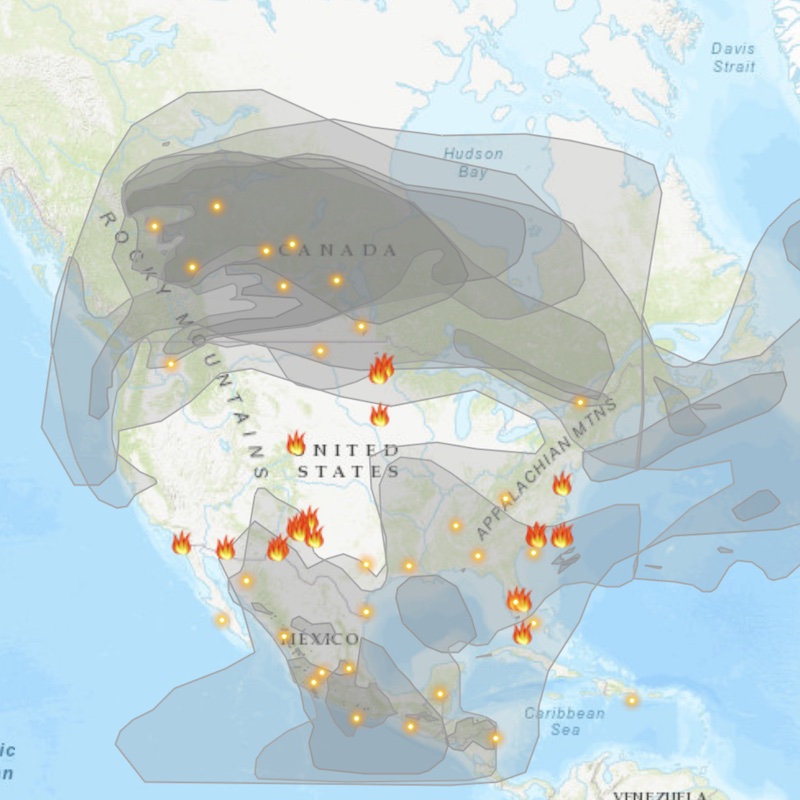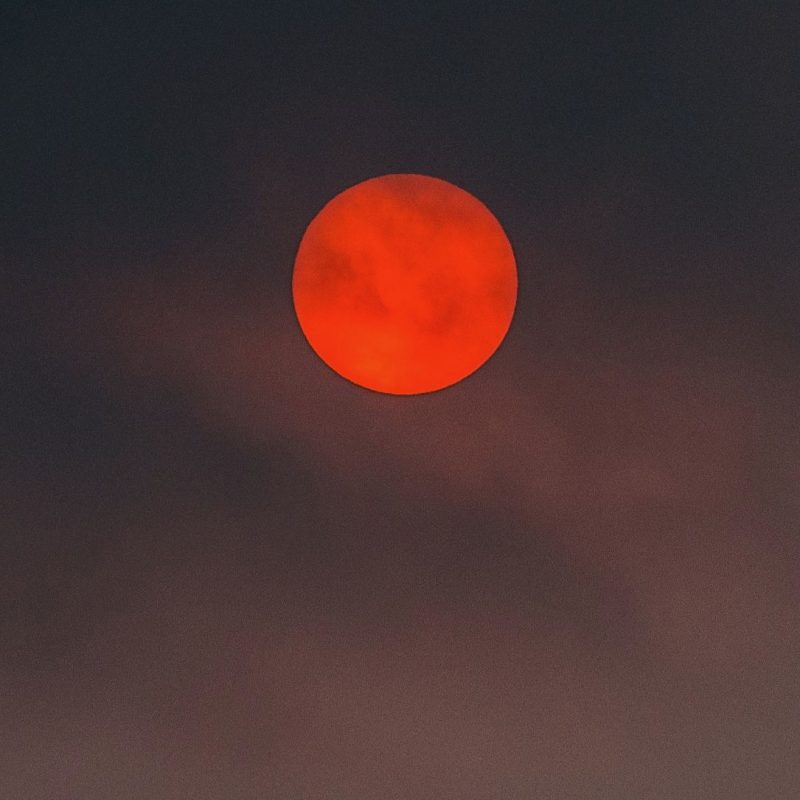
Wildfires, and red suns and moons
Wildfires raging in western North America in 2023 – beginning first in Alberta, Canada, and spreading to neighboring provinces Saskatchewan and British Columbia – have sent smoke careening across North American skies. Many people have noticed hazy skies overhead or seen at a distance, or red suns and moons. But what makes the sun and moon turn red?
Les Cowley publishes the great website Atmospheric Optics and is surely the world’s best-known living master of the physics of sky phenomena. Here’s his explanation for red suns and moons during wildfire season:
The color of our skies is a matter of the sizes of the particles making up our air. It’s also a function of the number of particles per unit volume in air, and to a much lesser extent – during wildfire season – the color of soot itself.
Particles smaller than visible light wavelengths scatter short wavelengths (e.g. blue light) much more strongly than long wavelengths (red). This is known as Rayleigh scattering, named for Lord Rayleigh in the 19th century, who derived the small particle limit. Lord Rayleigh determined that the scattering goes as the inverse fourth power of the wavelength.
Hence, blue light is scattered some 10 to 15 times more than red light. Air molecules scattering in this manner are what generate our blue skies.
Note that the light of even glorious red sunsets still has some transmitted blue. Not all is scattered away!
As particles get bigger they still scatter blue more than red, but the wavelength dependence weakens from the Rayleigh limit of the fourth power. Particles several times larger than light wavelengths scatter all wavelengths more or less equally.
Fresh smoke is an intermediate case. Look at a campfire sideways-on to the sunlight direction, and you’ll see its smoke is blue. If you are unfortunate enough to be downwind and in the smoke, the sun is reddened,
The wildfire smoke over the U.S. West [in 2020 was] largely in this regime. It scatters away more blue, and the sun’s transmitted light is reddened (but not completely denuded of blues).
All this holds for single scattering where a sun ray is scattered by only one particle before reaching the eye. Where the smoke clouds are dense, there is significant multiple scattering. In the limit of an optically thick cloud, the light inside the cloud (or sky) becomes a uniform color: that of the incident light before significant multiple scattering. Thus, clouds are white inside, and a clear blue sky gets milky white toward the horizon. Multiple scattering will modify the sky colors in San Francisco in the year 2020, for example, to an almost uniform orange-red. It is orange-red because the sunlight reaching the dense smoke has already been reddened by less dense smoke.
Sky colors with multiple scattering get complicated and need mathematical modeling to make predictions.
If you’ve captured photos of a strange colored moon, sun or sky due to smoke from wildfires, share it with EarthSky at EarthSky Community Photos!
May 15, 2023, smoke map for North America

Red suns and moons from 2021




Remember 2020’s red skies over California?
#Rogerdeakins is such a brilliant cinematographer, he nailed the orange sky . The power of cinematography can never be underestimated.#SanFranciscosky pic.twitter.com/Xkrzd1ukGQ
— Vijay Ganapathy G (@VijayGanapathyG) September 11, 2020

Bottom line: Wildfire smoke is already drifting across North America in 2023, creating redder-than-usual sunsets. Here’s why wildfires cause red suns and moons.
The post Why wildfires create red suns and moons first appeared on EarthSky.
from EarthSky https://ift.tt/dfryawi

Wildfires, and red suns and moons
Wildfires raging in western North America in 2023 – beginning first in Alberta, Canada, and spreading to neighboring provinces Saskatchewan and British Columbia – have sent smoke careening across North American skies. Many people have noticed hazy skies overhead or seen at a distance, or red suns and moons. But what makes the sun and moon turn red?
Les Cowley publishes the great website Atmospheric Optics and is surely the world’s best-known living master of the physics of sky phenomena. Here’s his explanation for red suns and moons during wildfire season:
The color of our skies is a matter of the sizes of the particles making up our air. It’s also a function of the number of particles per unit volume in air, and to a much lesser extent – during wildfire season – the color of soot itself.
Particles smaller than visible light wavelengths scatter short wavelengths (e.g. blue light) much more strongly than long wavelengths (red). This is known as Rayleigh scattering, named for Lord Rayleigh in the 19th century, who derived the small particle limit. Lord Rayleigh determined that the scattering goes as the inverse fourth power of the wavelength.
Hence, blue light is scattered some 10 to 15 times more than red light. Air molecules scattering in this manner are what generate our blue skies.
Note that the light of even glorious red sunsets still has some transmitted blue. Not all is scattered away!
As particles get bigger they still scatter blue more than red, but the wavelength dependence weakens from the Rayleigh limit of the fourth power. Particles several times larger than light wavelengths scatter all wavelengths more or less equally.
Fresh smoke is an intermediate case. Look at a campfire sideways-on to the sunlight direction, and you’ll see its smoke is blue. If you are unfortunate enough to be downwind and in the smoke, the sun is reddened,
The wildfire smoke over the U.S. West [in 2020 was] largely in this regime. It scatters away more blue, and the sun’s transmitted light is reddened (but not completely denuded of blues).
All this holds for single scattering where a sun ray is scattered by only one particle before reaching the eye. Where the smoke clouds are dense, there is significant multiple scattering. In the limit of an optically thick cloud, the light inside the cloud (or sky) becomes a uniform color: that of the incident light before significant multiple scattering. Thus, clouds are white inside, and a clear blue sky gets milky white toward the horizon. Multiple scattering will modify the sky colors in San Francisco in the year 2020, for example, to an almost uniform orange-red. It is orange-red because the sunlight reaching the dense smoke has already been reddened by less dense smoke.
Sky colors with multiple scattering get complicated and need mathematical modeling to make predictions.
If you’ve captured photos of a strange colored moon, sun or sky due to smoke from wildfires, share it with EarthSky at EarthSky Community Photos!
May 15, 2023, smoke map for North America

Red suns and moons from 2021




Remember 2020’s red skies over California?
#Rogerdeakins is such a brilliant cinematographer, he nailed the orange sky . The power of cinematography can never be underestimated.#SanFranciscosky pic.twitter.com/Xkrzd1ukGQ
— Vijay Ganapathy G (@VijayGanapathyG) September 11, 2020

Bottom line: Wildfire smoke is already drifting across North America in 2023, creating redder-than-usual sunsets. Here’s why wildfires cause red suns and moons.
The post Why wildfires create red suns and moons first appeared on EarthSky.
from EarthSky https://ift.tt/dfryawi

Aucun commentaire:
Enregistrer un commentaire